Last month concluded with two important events. First the SCI Members' Forum. These get better each year and this year's was organised by the Membership Affairs Committee (MAC) with a clear purpose as well as a good report back to show the actions taken as a result of the 2011 Forum. This year's topics were; Membership recruitment and retention, Income generation, Communication and Hubs. Each topic produced good discussions and some pointers which MAC will be taking forward in 2013.
The following day the BioResources Group held a conference entitled 'More Crop per drop'. This excellent event discussed the issues raised by the increasing demand for food and water from an expanding world population. A recurring theme in several talks suggests that while science can provide solutions to this dilemma, the main barriers to success are political and cultural. A report on this meeting is planned for our next newsletter.
Earlier this year Warwick Crop Centre threw open its doors for a day and we took the opportunity to look around. Meanwhile Margaret Waddy ventured further afield to the gardens of Northern Ireland. Reports on these visits appear below.
Editor
Warwick Crop Centre
Earlier this autumn the Warwick Crop Centre held an open day to demonstrate some of its current activities. The Crop Centre is located on the former Horticulture Research International (HRI) site at Wellesbourne, Warwickshire.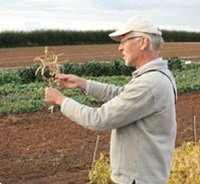
The constant battle against pest and disease provides the centre with a steady stream of projects from monitoring insect movements to understanding their life cycles and movements to the study of cultural, chemical and non-chemical methods of control.
As well as working on traditional crops, the centre also investigates new species and varieties that could become potential crops in the future. One of these is the navy bean (Phaseolus vulgaris) better known to most people in its normal guise as the baked bean. A breeding programme was conducted at Wellesbourne in the 1980s and material left from this programme is now being re-examined and used to restart breeding.
Existing varieties are adapted to warmer climates than the UK, so major objectives are to improve cold tolerance and earliness of ripening. After a cold damp summer which would have provided a good test of these attributes some of the selections on show certainly looked promising, as demonstrated by Prof Eric Holub right.
The former Vegetable Gene Bank that has been operating at Wellesbourne since the early 80s is now known as the Genetic Resource Unit (GRU). This unit continues the work of maintaining the seed bank as part of the European Cooperative Programme for Plant Genetic Resources concentrating particularly on brassicas and alliums. However, funding for the unit is currently guaranteed only until 2014.
While many of the former HRI facilities currently lie unused, they remain available for the crop centre should the occasion arise. So, although a sad shell of the former HRI, the Crop Centre continues to provide a valuable resource for the horticulture industry.
Peter and Sue Grimbly
Mount Stewart, Northern Ireland

First, Mount Stewart (pictured right), on a peninsula between the Irish Sea and Strangford Lough in County Down. The house has grown over time, since Alexander Stewart acquired the demesne in 1744. There are features such as the 'Temple of the Winds'; a fairly faithful imitation of its model in Athens, commissioned in 1782 by Robert Stewart, 1st Marquess of Londonderry.
But the grounds had to wait for Edith, wife of the 7th Marquess, to lay them out in the early 20th century and plant them as in their present form. Edith had to consider a climate that would support subtropical plants, in the same way as Tresco and Inverewe. She consulted with influential friends who had similar sites. She corresponded with Gertrude Jekyll, who advised on the design and planting of the Sunken Garden close to the house. And Edith benefited by 'acquiring' 20 ex-servicemen after WWI, to carry out her planting schemes.
The garden features some of the earliest eucalypts planted in the UK, which flourish in our temperate climate. We owe the diversity of our plants to a succession of intrepid plant hunters, who braved injury and even death to bring back new plant species from the four corners of the earth.
Given a hundred acres or so, a lake and sloping grounds, and a west front to the house overlooking Strangford Lough, what would you do? What Edith did was to set out a series of discrete, formal gardens in continental styles, surrounding the west, south and north sides. The Sunken Garden is surrounded by yews clipped into arches, with a summerhouse gazing out over a pond. Its interior features Turkish tiles. There are plenty of walls to support climbing roses, wisteria and clematis - as does the west front - and some exquisite wrought iron gates.
For me, the two most memorable enclosures are the Mairi Garden, at whose heart is a fountain with a statue of 'Mairi, Mairi, quite contrary', complete with silver bells and cockle shells. The other is the Shamrock Garden. Yew hedges are clipped into a number of Irish 
To the east is the lake, replete with broods of coots and mallards. Heading eastwards through parkland, you may walk round it; maybe first heading up the nearby slope to Tir nan Og (Land of the Ever Young) - alias the family graveyard. Junipers stand in for cypresses here; plenty of tender plants like bottlebrushes clothe the slopes. The lake provides amazing vistas; acers in leaf of various colours, and rhododendrons in flower. And luckily, the sun shone.
Margaret Waddy
Plant of the Month
Mahonia lomariifolia, Berberidaceae
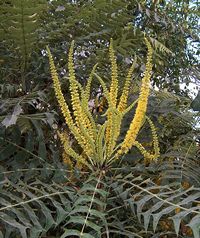
There are now approximately 70 known species in this evergreen shrubby genus although there is some debate between botanists as to whether Mahonia deserve to be a separate genus or to be 'sunk' into Berberis.
Mahonia lomariifolia hails from the area encompassed by Yunnan and Sichuan provinces in China, Northern Burma and Taiwan. It is a tall shrub, although can be somewhat tender in the UK climate. It has large pinnate leaves, and with 14 to 20 leaflets (plus terminal leaflet) it has more leaflets than most other Mahonia species.
The scented flowers are a sunny yellow colour and light up dark, dreary days in winter. Definitely worth giving garden space to.
Alison Foster
Oxford Botanic Garden
Medicinal Plant of the Month
Mahonia aquifolium, Berberidaceae (Oregon grape, tall Oregon grape)
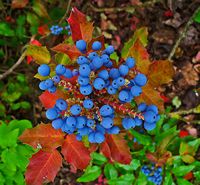
As the common name suggests, this plant comes from North America - on the west coast from Alaska as far south as Northern California. It is the state flower of Oregon. The inner bark of the stems and roots yields a yellow dye.
Some plateau Indian tribes used the Oregon grape to treat dyspepsia and the root is used commonly as an effective alternative to the threatened plant goldenseal (Hydrastis canadensis), since they both contain the same active 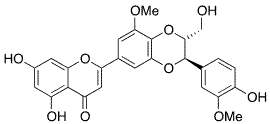
Ref: Proc Nat Acad Sci, 97, 4, 1433-7 (2000)
Alison Foster
Oxford Botanic Garden
News from our Associates
Commercial Horticultural Association

Similar benefits can be obtained at IPM Essen in Germany and Salon du Vegetal in Angers, France.
National Horticultural Forum
The NHF continues to be primarily involved in helping the establishment of the Horticultural Innovation Partnership or HIP. This new organisation may well take over from the NHF in due course. The HIP will be chaired by Mary Boseley, whose career has spanned a number of technology posts in horticultural marketing, including spells at Marks and Spencer, and more recently Waitrose.
Horticulture Industry News
For the very latest horticultural news follow us on Facebook and or
Twitter.
Improved control of fruit ripening
Biologists may have unearthed the potential to manipulate the functions of chloroplasts, the parts of plant cells responsible for photosynthesis. Researchers at the University of Leicester discovered that chloroplasts are affected by the ubiquitin proteasome system (UPS) - a process which causes the breakdown of unwanted proteins in cells, previously thought to only act on central parts of the cell.
As a result, they believe they may be able to use specific proteins to regulate the functions of chloroplasts - such as the conversion of chloroplasts into highly-pigmented chromoplasts during the ripening of fruit. They have identified a gene (SP1) in the nuclei of plant cells that codes for a protein called a ubiquitin E3 ligase, which is able to regulate chloroplast development through the UPS process. The team is already investigating the potential for harnessing the SP1 gene in crop plants, for example to affect the ripening of fruits such as tomatoes, bell peppers and citrus.
Coconut gene bank under threat
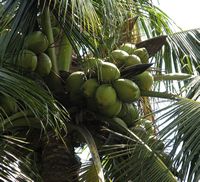
A similar disease threat prompted the move of the Forestry Commission 'Gene Bank' collection, from Knightshayes to a more isolated site in East Devon. See our July Newsletter.
Calcium pumps have two speeds
Studies have shown that calcium pumps in both animals and plants work together with the protein calmodulin. Some of the many calcium ions in a cell bind to calmodulin, which is then able to activate the calcium pump. Scientists have now purified the part of the calcium pump that interacts with calcium-activated calmodulin, and successfully crystallised a protein complex.
To their surprise, the calcium pump was found to bind two calmodulin proteins, and not just one as always assumed. This means that the calcium pump has three steps. It is switched off when no calcium-activated calmodulin is bound, it pumps at medium speed when binding occurs at one calmodulin protein, and it pumps at full speed when both calmodulin proteins are bound. This two-speed process enables the cell to conserve energy. More
Plant Pathologists being lost
An Audit of Plant Pathology Training and Education in the UK found that under half of the 103 Higher Education Institutes (HEI) offering biology, agriculture, horticulture or forestry at BSc level, provide teaching in plant pathology, and this can be as little as one or two lectures. Only a quarter of these (only about one in seven of all HEI in the UK) teach plant pathology practical classes, so critical hands-on training and expertise is at risk.
Jumping gene turned the tomato red
Tomato flavour is dependent upon a complex mixture of volatiles including multiple acetate esters. Red-fruited species accumulate a relatively low content of acetate esters in comparison with the green-fruited species. It has now been shown that the difference in volatile ester content between the red- and green-fruited species is associated with insertion of a retrotransposon adjacent to the most enzymatically active member of a family of esterases.
This insertion causes higher expression of the esterase, resulting in the reduced levels of multiple esters making them more palatable to humans. The insertion was evolutionarily fixed in the red-fruited species, suggesting that low ester content may have provided an adaptive advantage in the ancestor of the red-fruited species. More
Syngenta Horticultural Services sold to Griffin....
Griffin Greenhouse Supplies Inc, a leading United States-based supplier of greenhouse and nursery materials, has signed an agreement to acquire the Syngenta Horticultural Services (SHS) distribution and brokerage business. The transaction will include the transfer of SHS assets and employees as well as distribution and brokerage capabilities located in the USA. SHS had sales of $96m in 2011. Griffin has also signed a long-term agreement to distribute and broker Syngenta Flowers genetics throughout the USA.
...and BASF buys Becker Underwood
BASF has purchased Becker Underwood from its former owner Norwest Equity Partners for US$1.02 bn (£634m ). Becker Underwood is best known in the UK for its nematode-based products Nemasys and Nemaslug, based on work originally conducted at the former Glasshouse Crops Research Institute.
Coffee threatened by climate change
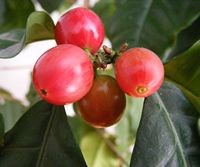
Arabica is one of only two species of bean used to make coffee and accounts for 70% of the global market, including almost all fresh coffee sold in high street chains and supermarkets in the US and most of Europe. More
Plant-Based Omega-3 is good for your heart
An evaluation of how the plant-based omega-3 fatty acid, alpha-linolenic acid (ALA), offers protective effects on cardiovascular diseases (CVD) found ALA to be associated with a lower risk of CVD, particularly coronary heart disease (CHD) death. These findings support the potential heart health benefits of ALA and suggest consumers should obtain adequate amounts of ALA in their diets. Walnuts are a key source of ALA and the only nut that provides a meaningful amount offering 2.5 grams of ALA in a mere handful. The type of omega-3s found in walnuts and other plant sources are different from the type of omega-3s found in fish. More
Greenhouse gas converted to fuel
Reducing or 'breaking apart' carbon dioxide molecules is difficult because carbon dioxide is very stable. However a step in that direction may have been achieved. In the course of studying bacterial enzymes used in nitrogen reduction, known as nitrogenases, researchers discovered a molybdenum nitrogenase capable of converting carbon monoxide into hydrocarbons.
They then used genetic engineering to remodel the nitrogenase protein, so it can convert carbon dioxide into methane, though only in very small amounts. This provides a path to learn how to turn carbon dioxide into useful chemicals and fuels, but the continuing challenge will be figuring out how this process works, and then transferring that knowledge to the construction of robust catalysts that can remove carbon dioxide from the atmosphere, and turn it into something useful. More
Events Calendar
Other Events of Interest
Good Agricultural Practices (GAP) for Greenhouse Vegetable Production in the Mediterranean Region
9 - 12 Dec, International Society for Horticultural Science
Baqa', Jordan
International Crop Science Conference and Exhibition
6 - 9 Jan, Pesticide Manufacturers Association of India
Nairobi, Kenya
IPM Essen
22 - 25 Jan, Messe Essen, see also Commercial Horticultural Association
Essen, Germany
British Herb Trades Association Annual Conference
26 Jan, British Herb Trades Association
Warwick, UK
Fruit Logistica
6 - 8 Feb, Messe Berlin, see also Commercial Horticultural Association
Berlin, Germany
Landscape Industry Show
13 - 14 Feb, California Landscape Contractors Association
Los Angeles, USA
Salon du Vegetal
19 - 21 Feb, Bureau Horticole Régional, see also Commercial Horticultural Association
Angers, France
New Technologies for Sustainable Agricultural Production and Food Security
24 - 26 Feb, International Society for Horticultural Science
Muscat, Oman
Poland - Chance or Challenge
2 - 9 March, Under 40s Fruit Growers Tour
Poland
Pesticide Use and Risk Reduction for Future IPM in Europe
20 - 22 Mar, Fondazione Edmund Mach, Pure, Laimburg
Riva del Garda, Italy
From farm to fork - plant molecular breeding and post-harvest research in the 21st century
23 Mar, PlantLink, Food Technology at Lund University and Department of Plant Breeding
Lund, Sweden
Crop Resource Use Efficiency and Field Phenotyping
25 - 26 Mar, Association of Applied Biologists
Grantham, UK
Middle East Horticultural Summit
26 Mar, International Society for Horticultural Science
Dubai
Temperate Zone Fruits in the Tropics and Subtropics
26 - 28 Mar, International Society for Horticultural Science
Chiang Mai, Thailand
If you would like to advertise a forthcoming event please contact charne.green@soci.org
Horticulture Group Contact Details
For submitting ideas or to volunteer to be part of a committee or a group, please contact:
Chairman - Peter Grimbly
Meetings Secretary - Alison Foster
Minutes Secretary - Margaret Waddy
Newsletter co-ordinator - Sue Grimbly scihortigroup@btinternet.com
Group Contact - Charne Green charne.green@soci.org T: +44 (0)20 7598 1594
